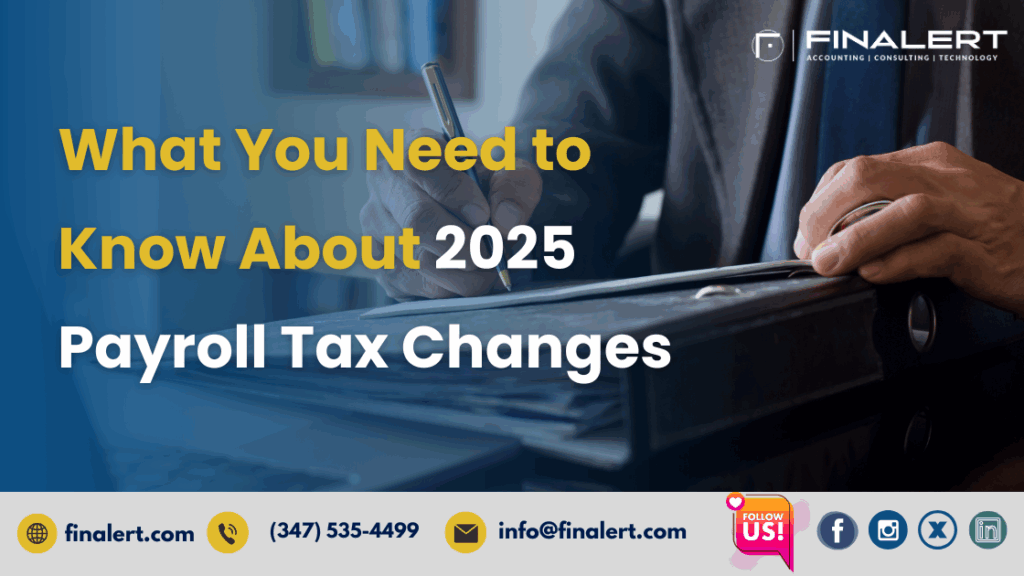
As we move into the 2025 tax year, payroll updates are already reshaping how businesses manage employee compensation, benefits, and compliance. Whether you run a small startup or a growing enterprise, staying informed about these changes is crucial, not just to avoid penalties but to take advantage of new opportunities for tax efficiency.
This guide breaks down the most important payroll tax changes for 2025 and offers practical insights on what business owners need to do now to stay ahead.
In 2025, the maximum earnings subject to Social Security tax will increase to $176,100, up from $160,200 last year. Both employers and employees will continue paying 6.2% on wages up to this cap, meaning higher earners will see a larger chunk of their income taxed.
The base Medicare tax rate remains at 1.45%, with no wage cap. Additionally, employees earning over $200,000 (single filers) will continue to pay an extra 0.9% in Medicare taxes. Employers do not match this additional tax.
The IRS has adjusted withholding tables for inflation. These updated brackets impact how much federal income tax is withheld from employee paychecks. Employers need to ensure their payroll software or provider has integrated these new calculations to avoid under or over-withholding.
Employees can now contribute up to $23,500 to their 401(k) plans—$500 more than in 2024. This change allows for greater pre-tax savings and may require employers to update plan documents or employee communication materials.
Health Savings Accounts (HSAs) and Flexible Spending Accounts (FSAs) also saw adjustments:
These adjustments are a great opportunity for employers to promote these benefits and encourage smart financial planning among employees.
Employers offering transportation or parking fringe benefits can now provide up to $325 per month tax-free. If your business offers commuting subsidies or transit cards, it’s time to revisit your benefit caps.
One of the more publicized changes for 2025 is the new federal tip income exclusion. Employees in eligible service roles can now exclude up to $25,000 in reported cash tips from federal income tax. The change primarily benefits hospitality and restaurant workers and helps employers by offering corresponding payroll tax relief.
Employees can now deduct up to $12,500 in overtime pay from their taxable income. Joint filers can deduct up to $25,000. This deduction, available through 2028, rewards hourly employees while giving employers an incentive to fairly compensate for overtime work.
Employers should ensure that these deductions are clearly explained in pay statements or onboarding materials, particularly for hourly roles.
The research and development (R&D) payroll tax credit has been expanded. Eligible businesses, especially startups, can now apply up to $500,000 of their R&D credit against payroll taxes, rather than income tax.
This shift makes the credit more accessible to early-stage companies that may not yet be profitable. If you engage in product development, custom software, or technical innovation, this credit is worth exploring further with your tax advisor or CFO.
Bonuses, commissions, and other supplemental wages continue to require a separate flat-rate withholding method. Be sure your payroll system applies the correct rate when issuing non-regular payments to avoid discrepancies at year-end.
The backup withholding rate remains at 24%. This applies when payees fail to provide a valid taxpayer identification number (TIN) or are otherwise flagged for withholding by the IRS.

The IRS and Department of Labor continue to scrutinize worker classification. If you engage independent contractors or freelancers, you’ll want to double-check:
Misclassifying workers can result in unpaid payroll taxes, back benefits, and fines, so review your contractor agreements carefully.
Many states and municipalities have also updated payroll-related laws, including:
Employers operating in multiple states—or employing remote workers—should track these changes carefully. A multi-state payroll review early in the year can prevent costly surprises.
To stay compliant and tax-efficient in 2025, we recommend business owners and payroll administrators take the following steps:
1. Update Payroll Systems and Software
Make sure your payroll provider has implemented all 2025 federal and state tax updates.
2. Review Compensation Policies
Inform employees about new contribution limits, deductions, and benefits. Adjust withholding elections where necessary.
3. Revisit Worker Classification
Double-check that contractors meet legal standards for independent work.
4. Track Tax Credit Eligibility
If you’re investing in innovation, automation, or workforce development, explore available credits early.
5. Review Multi-State Compliance
Update wage and tax rates for each jurisdiction in which your employees operate.
6. Train Internal Teams
Ensure HR, finance, and payroll staff are aware of key changes and how to implement them.
The payroll tax landscape in 2025 includes both routine adjustments and meaningful new opportunities. Understanding these changes—and responding proactively—will help your business stay compliant, competitive, and efficient in its financial planning.
Whether you’re an employer with 5 employees or 500, adapting early to these payroll shifts is critical. With the right systems and advice in place, these changes can go from administrative burden to bottom-line benefit.
If your team needs guidance implementing these updates or evaluating payroll strategy, a professional advisory like Finalert can provide clear, actionable support. Let us know if you’d like to help tailor a plan for your business.
Similar Articles
No results available
Get in touch with Finalert today for tailored business solutions!
No results available
Ready to thrive? Connect with Finalert today and let’s succeed together in the dynamic global market.
© 2025 Finalert. All rights reserved.
Ready to thrive in the dynamic global market? Finalert LLC offers expert financial services, including accounting, consulting, and technology solutions, tailored to your business needs.
Address
Accounting
Quick Links
Consulting
Industries
© 2025 Finalert LLC. All rights reserved.